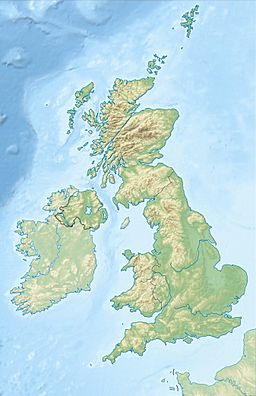Croxall Lakes facts for kids
Quick facts for kids Croxall Lakes |
|
|---|---|

View north of the western lake
|
|
| Location | National Forest, Staffordshire, United Kingdom |
| Coordinates | 52°43′39″N 1°43′14″W / 52.727461°N 1.720452°W |
| Type | Quarry lake |
| Surface area | West: 11 ha (27 acres) East: 2.7 ha (6.7 acres) |
Croxall Lakes is a special nature reserve in the United Kingdom. It's found between the villages of Croxall and Alrewas in Staffordshire. This reserve has two lakes and grassy areas in between them.
The lakes were made when people dug up sand and gravel. These big holes later filled with water. Then, the area was fixed up to become the nature reserve we see today. The Staffordshire Wildlife Trust looks after the reserve. The National Forest Company owns it. It's a very important place for many birds that are migrating (flying long distances). This is because three rivers – the Trent, Tame, and Mease – meet nearby.
Contents
Where are Croxall Lakes?
Croxall Lakes is in the southeast part of Staffordshire, England. It sits between the villages of Alrewas and Croxall. The lakes are right next to the National Memorial Arboretum. They are also close to where the River Tame and River Mease join the River Trent.
The lakes exist because of the ground beneath them. This area has lots of sand and gravel from the last Ice Age. People dug up this sand and gravel for building and other industries. This happened in many places along the Trent Valley.
During the 1990s, a company called Lafarge Aggregates dug up a lot of the land. This created deep pits that later filled with water. In the early 2000s, the digging stopped. The National Forest Company bought the land. They wanted to fix it up and keep it as a nature reserve. Now, the lakes are at the southern edge of the National Forest. They act as a welcoming spot into the forest.
What Can You See at Croxall Lakes?
The reserve covers about 24.2 hectares (that's like 60 football fields!). It's built around the old sand and gravel pits. The reserve has two lakes. A main railway line, used by the Cross Country Route, runs between them.
The western side has a large lake, about 11 hectares in size. The eastern side has wet grasslands and fields. It also has mature trees around a smaller lake, which is about 2.7 hectares. You can get into the reserve from a car park at the southern end. There are also hard pathways to walk on. Along the lake shores, you'll find places to hide and watch birds. These are called bird hides and screens.
On the north-eastern shore of the western lake, there is a special "Noon Column." It was put there in 2006 as part of a project by the National Forest Company. The artist David Nash made it from English oak wood. On the longest and shortest days of the year (midsummer and midwinter), the sun shines through a slot in the column. For about 10-15 minutes, it creates a line of light in the column's shadow.
Amazing Wildlife
The lakes are a perfect resting spot for birds flying long distances. This is because three rivers meet here. Different birds visit the reserve at different times of the year.
In winter, you might see ducks like mallards, Eurasian teals, wigeons, common goldeneyes, and northern shovelers on the lake. In early summer, birds like lapwings, oystercatchers, redshanks, and ringed plovers come to breed. Other birds you might spot include the short-eared owl, skylark, Canada goose, and song thrush. You might also see mammals like otters and water voles in the reserve.
The Staffordshire Wildlife Trust has worked hard to make this place great for wildlife. They have dug shallow pools for wading birds. They also created shallow areas and reedbeds on the lakes. These spots give birds places to hide and build nests. They also reshaped some of the banks. The soil from this was put into the lake to make more shallow areas and bigger reedbeds. This process helps the river flow more naturally. It creates different habitats like still pools and gravel islands. This helps many different kinds of wildlife.
The River Mease joins the River Trent near the reserve. This river is a Site of Special Scientific Interest. This means it's a very important place because of its otters, native white-clawed crayfish, and spined loach.
Who Manages Croxall Lakes?
The reserve is part of the National Forest. The Staffordshire Wildlife Trust takes care of it. The National Forest Company bought the land from Lafarge in 2000. They got help from Severn Trent Water to buy it. Other groups like the Staffordshire Environmental Fund, the Environment Agency, and DEFRA helped pay for the work to develop the reserve.
Images for kids
-
The larger lake viewed across the lower Tame from the National Memorial Arboretum, showing a connecting channel, allowing flood water to flow between river and lake.
-
Croxall lakes viewed from highest point of Arboretum, across the Tame.
-
View westward across the main, western lake at Croxall, which is about 11 hectares in area. The Tame lies below the embankment on the far side of the lake.






